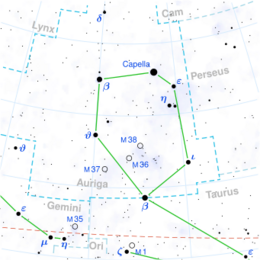Astronomy:HD 32188
| Observation data Equinox J2000.0]] (ICRS) | |
|---|---|
| Constellation | Auriga |
| Right ascension | 05h 03m 18.63675s[1] |
| Declination | +41° 26′ 29.9355″[1] |
| Apparent magnitude (V) | 6.08[2] |
| Characteristics | |
| Spectral type | A2IIIshe[3] |
| U−B color index | +0.22[2] |
| B−V color index | +0.21[2] |
| Variable type | Suspected[4] |
| Astrometry | |
| Radial velocity (Rv) | −0.7[5] km/s |
| Proper motion (μ) | RA: −0.44[6] mas/yr Dec.: −1.89[6] mas/yr |
| Parallax (π) | 1.0886 ± 0.0733[1] mas |
| Distance | 3,000 ± 200 ly (920 ± 60 pc) |
| Absolute magnitude (MV) | −2.87[3] |
| Details | |
| Radius | 30.39+1.63 −0.99[1] R☉ |
| Luminosity | 2,428±207[1] L☉ |
| Temperature | 7,350+123 −189[1] K |
| Rotational velocity (v sin i) | 23[7] km/s |
| Other designations | |
| Database references | |
| SIMBAD | data |
HD 32188 is suspected variable star[4] in the northern constellation of Auriga, and is positioned roughly in between Eta and Zeta Aurigae. It has a white hue and is just barely visible to the naked eye with an apparent visual magnitude that fluctuates around 6.08.[2] The distance to this star is approximately 3,000 light years, based on parallax.[1] It has an absolute magnitude of −2.87.[3]
This object is an A-type giant star with a stellar classification of A2IIIshe.[3] The suffix notation indicates this is a shell star,[9] which means it has a peculiar spectrum indicating there is a circumstellar disk of gas around the star's equator. While the spectral luminosity class is III, analysis of its colour and brightness suggest it more closely resembles a supergiant star.[3] HD 32188 has expanded to 30[1] times the radius of the Sun and it is spinning with a projected rotational velocity of 23 km/s.[7] It is radiating 2,428[1] times the luminosity of the Sun from its enlarged photosphere at an effective temperature of 7,350 K.[1]
References
- ↑ 1.0 1.1 1.2 1.3 1.4 1.5 1.6 1.7 1.8 1.9 Brown, A. G. A. (August 2018). "Gaia Data Release 2: Summary of the contents and survey properties". Astronomy & Astrophysics 616: A1. doi:10.1051/0004-6361/201833051. Bibcode: 2018A&A...616A...1G. Gaia DR2 record for this source at VizieR.
- ↑ 2.0 2.1 2.2 2.3 Guetter, H. H.; Hewitt, A. V. (June 1984), "Photoelectric UBV photometry for 317 PZT and VZT stars", Publications of the Astronomical Society of the Pacific 96: 441–443, doi:10.1086/131362, Bibcode: 1984PASP...96..441G.
- ↑ 3.0 3.1 3.2 3.3 3.4 Hauck, B.; Jaschek, C. (February 2000), "A-shell stars in the Geneva system", Astronomy and Astrophysics 354: 157–162, Bibcode: 2000A&A...354..157H.
- ↑ 4.0 4.1 Samus, N. N. et al. (2017), "General Catalogue of Variable Stars", Astronomy Reports, 5.1 61 (1): 80–88, doi:10.1134/S1063772917010085, Bibcode: 2017ARep...61...80S.
- ↑ Wilson, Ralph Elmer (1953), General Catalogue of Stellar Radial Velocities, Washington DC: Carnegie Institution of Washington, Bibcode: 1953GCRV..C......0W.
- ↑ 6.0 6.1 van Leeuwen, F. (2007), "Validation of the new Hipparcos reduction", Astronomy and Astrophysics 474 (2): 653–664, doi:10.1051/0004-6361:20078357, Bibcode: 2007A&A...474..653V.Vizier catalog entry
- ↑ 7.0 7.1 Royer, F. et al. (October 2002), "Rotational velocities of A-type stars in the northern hemisphere. II. Measurement of v sin i", Astronomy and Astrophysics 393: 897–911, doi:10.1051/0004-6361:20020943, Bibcode: 2002A&A...393..897R.
- ↑ "HD 32188". SIMBAD. Centre de données astronomiques de Strasbourg. http://simbad.u-strasbg.fr/simbad/sim-basic?Ident=HD+32188.
- ↑ Jaschek, M. et al. (March 1988), "A survey of AE and A-type shell stars in the photographic region.", Astronomy and Astrophysics Supplement Series 72: 505–513, Bibcode: 1988A&AS...72..505J.
External links
 |


